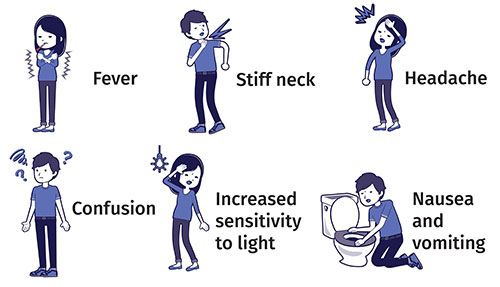Meningitis and college students

Symptoms of meningitis
Back to school season each fall often leads to many people developing illnesses such as the common cold, flu or even COVID-19. Talks of another illness — perhaps the most threatening to college students — can sometimes be forgotten.
This illness is meningitis, which is an infection of the brain and spinal cord that, according to the Minnesota Department of Health. causes death in up to one out of seven people who contract it. Although the disease itself is rare, one out of five of those who survive acquire severe disabilities such as seizures, deafness, loss of limbs and brain damage (Minnesota Department of Health).
A professional ballroom dancer, 32-year-old Rafael Castellano battled a severe case of meningitis for three months, beginning in June 2022. During this time, he had eight surgeries, was placed in a medically induced coma and had both of his legs amputated (NY Post). He said he did not know much about the disease before, and now hopes to spread awareness.
According to the Centers for Disease Control and Prevention, “infants, teens and young adults and older adults have the highest rates of meningococcal disease in the United States.”
College students living in close quarters such as in dormitories can be as much as six times more likely to acquire meningitis. It is spread through “sharing respiratory and throat secretions (saliva or spit). Generally, it takes close or lengthy contact to spread these bacteria. Those at increased risk of getting sick include people in the same household, roommates, or anyone with direct contact with the patient’s oral secretions, such as a kissing partner,” (Centers for Disease Control and Prevention).
Some symptoms commonly shown in those with meningitis may match those associated with a cold or the flu, such as fever, vomiting and headache. However, other symptoms present as the illness progresses.
“Limb pain, pale skin, and cold hands and feet often appear earlier than the rash, neck stiffness, dislike of bright lights and confusion,” Meningitis.org said. Being able to recognize symptoms and seek medical attention is extremely important, as the disease can “kill in hours,” (Meningitis).
There are two kinds of vaccinations available to prevent different strains of meningitis. The Meningococcal Conjugate or MenACWY is a vaccine that prevents strains A, C, Y and W. The first dose is taken between ages 11-12 and a booster is taken at age 16 (Centers for Disease Control and Prevention).
It is also recommended that teens and young adults at increased risk of acquiring meningitis, such as those living in dormitories, receive the MenB vaccine, which protects against Strain B. This strain has previously been found on college campuses (Graham Health Center). The MenB vaccine is available at pharmacies and doctor’s offices for those between the ages of 16-23.
Dr. Silvana Younan is an internal medicine physician at Farmington Hills Medical Center. She sees patients of all ages, including young adults, and has two children who are recent college grads.
“Vaccinating against meningitis is especially important for college students, especially considering the large population and close proximity of students in housing sites and dorm rooms,” Younan said.
She continued to describe the significance of spreading awareness and learning more about meningococcal disease, which can cause meningitis and other blood infections.
“Knowing about the disease and its symptoms, in addition to being vaccinated, can go a long way in keeping yourself and others in the campus safe,” Younan said.










